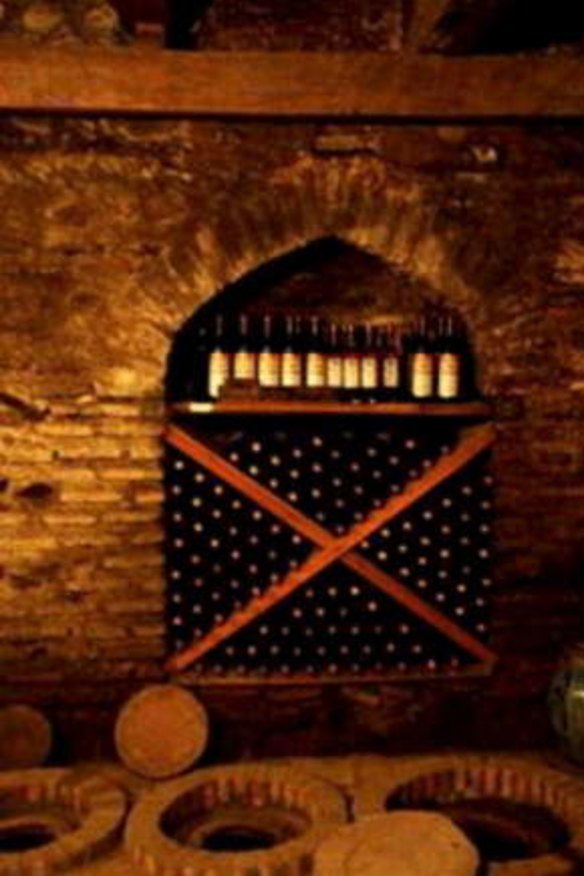Georgia on winemaker's mind
John Wurdeman sings the praises of Georgian clay vessels and amber wines.

Blame the traditional winemakers of Georgia, the former USSR state. They're behind the trend towards fermenting white wine on its skins in clay amphorae, concrete eggs and other strange vessels. It's loosely known as ''orange'' wine, and it's part of the ''natural'' wine movement that's taking root in many wineries, across Australia and the world.
The Georgians call their clay vessels qvevri (pronounced kwevri) and they're hardly new. The Georgians have been fermenting in these 2000 to 4000-litre clay vessels for thousands of years. They never stopped doing it: the modern wine movement, with its stainless-steel tanks, crusher-destemmers and French oak barriques, had little impact on Georgia.
According to a Georgian winemaker who attended the recent Rootstock Sydney wine festival, John Wurdeman of Pheasant's Tears winery, the qvevri is the only vessel used in Georgia. They've been used there for 8000 to 9000 years. "The qvevri is lined with acacia wax and buried in the earth," he explains. "It breathes like a barrel but imparts no flavour or tannin to the wine."

Today, qvevri are so fashionable throughout the winemaking world that even the Georgians must join a long queue to buy new ones.
Wurdeman, whose Pheasant's Tears wines have recently become available in Australia through importer Vinous Solutions, isn't a native Georgian: he's United States-born. An artist, he went to Moscow to study painting and, while there, learnt Russian. Then he discovered Georgia, fell in love with Georgian polyphony, a unique kind of choral part-singing, and went to live there, collecting musical recordings. He then learnt Georgian, as you do, which wasn't simple as it's a totally different language to Russian.
The Georgians have a vibrant tradition of music, food and wine, and Wurdeman quickly realised that whenever they drank and ate, they also sang, and whenever they sang, they ate and drank. Then he fell in love with Georgian wine, and resolved to make his own. In 2007 he established a wine-producing business with eighth-generation Georgian winemaker, Gela Paliashvili.
Pheasant's Tears has 12 hectares of vines in one province and seven hectares in another, and produces 38,000 bottles of wine a year. Its vines are managed according to biodynamic principles and have an organic certification.
Orange wines are fashionable in a fringe kind of way, and you'll find them on many smart restaurant wine lists, including Bentley, Fix St James, Quay and Momofuku Seiobo.
Wurdeman prefers the term amber wine, rather than orange.
"They're not white and they're not red, but in between," he says.
They're amber because they've been fermented with their skins: Pheasant's Tears' amber wines spend between one and six months on skins. This is most unusual, and much longer than the reds, which have a more normal 10 days to four weeks' skin maceration.
Not surprisingly, the amber wines are quite tannic because, as Wurdeman says, they're meant to go with food. This was graphically demonstrated to me. I tasted all eight wines he had brought, firstly without food, and then with food. The most charming, aromatic and easy to comprehend (to a regular Aussie palate) was the rkatsiteli, which is widely planted and is the preferred wine of Georgians. It lends itself to long times on skins, up to six months. The '09 was high in aroma and freshness, and low in tannin - notwithstanding the long time on skins. I could happily drink this without food.
The 2011 Kisi was formidably grippy and a little charmless. It was my least favourite white without food, but with food it suddenly became my favourite. It was transformed. And the rkatsiteli, which had been my favourite without food, did not satisfy at all with food. It lacked the structure to accompany food. My preferences were reversed. Without leading the witness, Wurdeman had made his point.
Pheasant's Tears produces wine from six varieties, all vitis vinifera and all indigenous to Georgia.
The wines are quite confronting, although not as difficult to taste as I had feared. There were no objectionable faults such as volatile acidity, sulphides, brettanomyces, mousiness or excessive oxidation - although I would have to say most drinkers accustomed to modern white wines may find the amber wines taste slightly oxidised, but not detrimentally. Wurdeman believes in giving his wines a little sulphur dioxide before bottling.
Pheasant's Tears
Dry Unfiltered Amber Wines
Chinuri 2011 $56 - One month on skins. Full amber hue, gingerbread aroma, soft light tannins.
Mtsvane 2011 - Three months on skins. Full orange-amber hue, vaguely citrusy, orange-peel and fruit compote aromas. Quite tannic.
Kisi 2011 $56 - Dried apricot, cooked fruit and crushed-seashell aromas. Very grippy tannins. This makes a statement.
Rkatsiteli 2009 $56 - Full orange-amber hue, spicy stone-fruit aromas, almost as spicy as traminer. Fruity, soft, round and balanced; low tannin.
Unfiltered red wines
Takveri 2012 $56 (due late April) - Ten days on skins. Clear, bright, deep red-purple; clean spicy and ironstone aromas. Light-bodied, soft and spicy taste, with gentle structure.
Saperavi 2007 $56 (due late April) - Four weeks on skins; two years in qvevri. Deep, dark colour; intense black fruits, licorice and spice aromas; very savoury, with ample but smooth tannins and good length. Full bodied but nothing like the inky monsters saperavi makes in Australia.
Retailers: Vintage Cellars Ultimo, Cremorne Cellars, The Oak Barrel.
